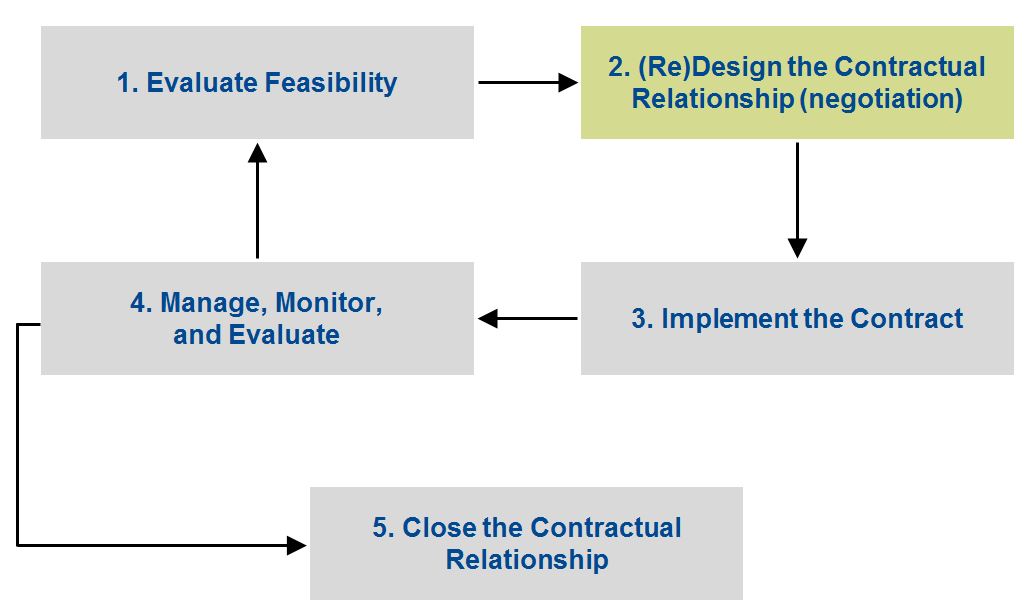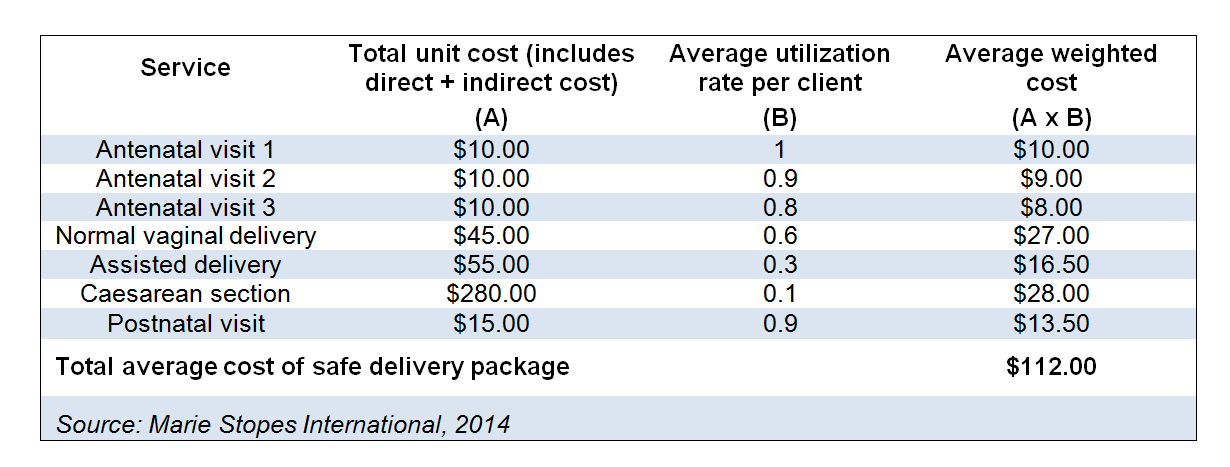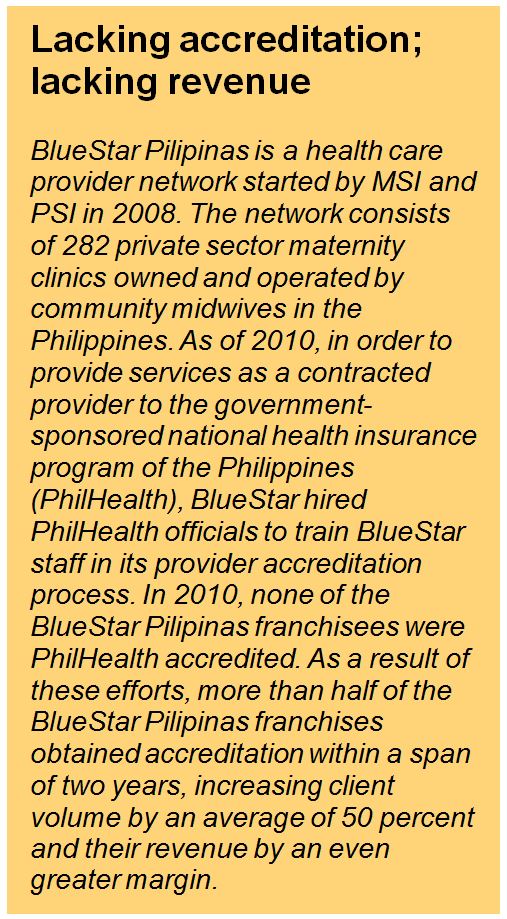Stage Two: (Re)Design the Contractual Relationship (negotiation)

To secure a new or renewed contract for family planning services, the SDO and the purchaser negotiate and agree upon the scope of services, including performance standards and reporting requirements. A key feature of the contract evaluation and design concerns the payment arrangement, including the method and amount of payment for services, any assumption of financial risk, incentives and disincentives, and so on.
- 2.1 What is the most common contracting method used to purchase family planning services?
- 2.2 What is capitation? What are advantages and disadvantages of this payment method?
- 2.3 What is performance based contracting? How does this affect how I will get paid?
- 2.4 How do I calculate costs of service delivery for my organization? When should costing be done?
- 2.5 What does a contract look like? Where can I find examples of contracts?
- 2.6 What is accreditation? Why is this important for my facility?
- 2.7 Are there general tips on what I should avoid in contracting-out FP services?
2.1 What is the most common contracting method used to purchase family planning services?
There are countless possibilities for the design of contracting approaches. Generally speaking, family planning services are paid for using fee-for-service and contracting terms are established for one to several years. They may be exclusive (in the case of a sole-source contract), or they may be non-exclusive and be offered to more than one contractor in the same locale.
In addition to the payment method and term of an agreement, other components of a contract are negotiable. The components include the list of covered services, terms for monitoring and evaluation, the use of audits, reporting standards, and terms of termination and dispute resolution. A range of payment methodologies is outlined in FAQ 1.8. Note that some groups of services, such as maternity care, may lend themselves to package pricing, whereas others may rely on payment for individual or “unbundled” services. SDOs should consider the entire range of potential obligations, risks and rewards that a contracting opportunity presents.
2.2 What is capitation? What are advantages and disadvantages of this payment method?
Capitation is a form of pre-payment for services that are expected to be delivered. Under capitation, an SDO prospectively receives a per capita payment for a defined set of services for a defined time period (for example, $5 per person per year). Capitation rates do not vary based on utilization. In more sophisticated capitation arrangements, the pre-payment can vary by covered person (for example, by age or gender).
Capitation is currently not a common payment method for family planning services, but it may become more common in the future. Capitation is more prevalent in high income countries, and government purchasers in countries such as Ghana and Thailand are adopting capitation to pay for primary care services inclusive of family planning services.
Capitation can provide a stable flow of funds and reduce administrative work related to fee-for-service billing, but it also shifts the financial risk of service utilization per client to the SDO. If service utilization by capitated clients exceeds what was budgeted, the compensation from the capitation payment from the purchaser may not cover the SDO’s costs. Conversely, if fewer services than budgeted are actually delivered, a capitation agreement may provide surplus revenue to the SDO.
2.3 What is performance-based contracting? How does this affect how I will get paid?
Performance-based contracting is a form of results-based contracting that departs from simpler types of contracts by setting a fixed price for a desired output and then adding a variable component that can reduce payment for poor performance or increase it for good performance compared to the standard defined in the basic contract (Loevinsohn 2008).
Examples of performance based indicators are:
Clinical:
- Percent target population served
- Number of clients by type of service, geography, referral source, or other subset
- Number of services provided by client, geography, or other subset
- Percent of postpartum or post-abortion family planning for women who want to space or limit births
Nonclinical:
- Client satisfaction, as evidenced by scores obtained from annual surveys (the process and frequency of a survey should reflect mutually agreed to terms between the SDO and the purchaser)
- Timeliness of quarterly reports
2.4 How do I calculate costs of service delivery for my organization? When should costing be done?
It is especially important to accurately calculate the main components of cost for family planning services when payments are pre-determined and are not cost-based, for example, with capitation. In such situations, for example, when the payment methodology includes prospectively set rates per service or for a package of services (for example, maternity care) the SDO assumes some financial risk. To determine if a proposed contract would be viable under pre-determined rates, the SDO must know its underlying costs and compare them to the proposed payment.
Most costs to deliver family planning services are associated with commodities and labor. These costs are classified as direct costs as they are largely a function of the volume of services provided and the costs per unit of service (for example, the cost for IUDs or condoms and the cost of a provider who delivers the service). Other costs, commonly referred to as indirect costs or overhead, are less variable based on volume, meaning they fluctuate less based on the amount of services delivered. Indirect costs are referred to as such because they are not easily traced to any individual service. Indirect costs include items such as building rent or maintenance, equipment, utilities, information technology, procurement, and other administration.
Note: When costing a package of “bundled” services, such as maternity care, the expected utilization of each service within the package must also be estimated to arrive at the expected cost to provide the package of services (Table 2). A rate for inflation is often appropriate to factor into estimates, especially in environments where inflation is high, or when bidding to provide services over a longer period (for example, multiple years).
Table 2. Example of costing a service package—maternity health care

 For more information on costing, as well as details and methods to determine costs for family planning services, refer to “Methods for Estimating the Costs of Family Planning” located in the Resources tab.
For more information on costing, as well as details and methods to determine costs for family planning services, refer to “Methods for Estimating the Costs of Family Planning” located in the Resources tab.
2.5 What does a contract look like? Where can I find examples of contracts?
Common provisions set forth the title of the contract, the contracting parties, the effective date and period of the agreement, and requirements for liability insurance. The services or deliverables under the contract are specified and details are included regarding the payment method and procedure (timeliness, banking details), performance requirements (and sanctions), reporting (data elements and frequency), monitoring, and evaluation. Additionally, the contract should specify how it can be modified or terminated, and what course of action parties to the contract may follow to resolve disputes. SDOs should confirm that contracts are legally binding in the jurisdiction where they apply.
Marie Stopes International offers a general format on contracting documents in its primer, "Filling the Gap: Lessons for Policymakers and Donors on Contracting Out Family Planning and Reproductive Health Services."
2.6 What is accreditation? Why is this important for my facility?
Accreditation, sometimes referred to as certification, refers to an acknowledgement by a purchaser, industry body such as an association, or a government regulator that an SDO meets certain minimum standards and requirements, usually related to quality and breadth of services. Organizations as well as individual accreditation of professionals such as medical doctors, nurses, or financial accountants can be relevant.
Accreditation does not guarantee jobs or contracts with purchasers; however, it provides assurance that the facility is engaged in ongoing review and improvement of its quality. Accreditation ensures public accountability of a program or an SDO, which is recognized by purchasers when reviewing proposals for contracts.
 2.7 Are there general tips on what I should avoid in contracting-out family planning services?
2.7 Are there general tips on what I should avoid in contracting-out family planning services?
- Transaction costs are underestimated when negotiating contract terms, leading to potential losses if payments are insufficient to cover all costs.
- Contracting-out is viewed solely by a purchaser as a cost-reduction exercise; rather, it should be considered within a strategy to improve service delivery and coverage.
- Failing to recognize when contract management capacity of the purchaser or the SDO is insufficient to build and maintain an effective contractual relationship.
- Too little attention is paid to establishing performance targets and setting up a process for monitoring and reporting in the early stages of the contract.
- Performance-based payments are not readily linked to results of performance evaluations.
- Lack of trust, integrity, and cooperation from both parties can have a negative effect on a contractual relationship and may also lead to additional problems over the life of the contract.
- Entering into a contract that compromises the SDO’s mission and/or vision.